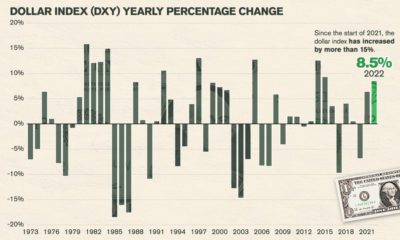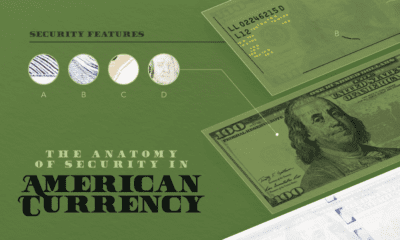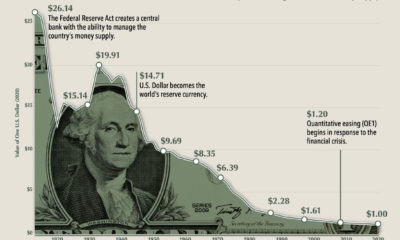When the Canadian dollar is strong, it means that going south of the border is cheaper. Whether it’s a vacation in Hawaii or a shopping spree in New York City, a strong Canadian dollar can buy more in terms of U.S. dollars. Likewise, a weak Canadian dollar can buy fewer U.S. dollars – meaning that travel, shopping, and other expenses in U.S. dollars are more expensive.
The Same Effect
The impact of currency fluctuations isn’t limited only to foreign purchases. In fact, as today’s infographic from Fidelity Investments Canada shows, these same fluctuations can also affect the performance of your portfolio. Why is that the case? Many Canadian portfolios have exposure to American-listed companies such as Apple, Wells Fargo, Tesla, or Johnson & Johnson. As a result, fluctuations in the USD/CAD rate can have a profound impact on how these investments perform in Canadian dollars.
How Does This Work?
Here’s an example of the impact of currency in action:
A Canadian investor puts $100 CAD into a fund that buys U.S. stocks At the time of investment, $1 CAD buys $0.80 USD After exchange, $80 USD is invested in the U.S. market The U.S. market goes up 10% in one year, and is now worth $88 USD However, over the year, the exchange rate changed to $1 CAD per $0.85 USD Converted back to Canadian dollars, at the new rate, the $88 USD is now worth $103.52 CAD, which is just a 3.5% gain in domestic Canadian currency
In the above case, a strengthening Canadian dollar ends up dampening the returns coming from the U.S. market. In contrast, if the exchange rate went the other direction – meaning Canadian dollar was weakening – any returns would actually amplify.
Long-Term Planning
If currency fluctuations can have a substantial impact on investments, what does this mean for portfolio construction and assessing risk? There are two main schools of thought on this: Hedged: Some funds use a hedging strategy to try and cancel out any currency fluctuations. Ideally, the end result of this would be representative performance of the U.S. market. Unhedged: This strategy does not try to anticipate currency fluctuations, since the long-term effects of currency movements tend to even out over time. According to Fidelity Investments Canada, over the 20-year period of November 28, 1997 to November 30, 2017, the impact of currency fluctuations on the S&P 500 had a difference in annualized returns of 0.5%. In other words, U.S. dollars invested in the S&P 500 had a 7.2% return, while Canadian dollars invested in the same stocks had a 6.7% return after adjusting for exchange rates. on Last year, stock and bond returns tumbled after the Federal Reserve hiked interest rates at the fastest speed in 40 years. It was the first time in decades that both asset classes posted negative annual investment returns in tandem. Over four decades, this has happened 2.4% of the time across any 12-month rolling period. To look at how various stock and bond asset allocations have performed over history—and their broader correlations—the above graphic charts their best, worst, and average returns, using data from Vanguard.
How Has Asset Allocation Impacted Returns?
Based on data between 1926 and 2019, the table below looks at the spectrum of market returns of different asset allocations:
We can see that a portfolio made entirely of stocks returned 10.3% on average, the highest across all asset allocations. Of course, this came with wider return variance, hitting an annual low of -43% and a high of 54%.
A traditional 60/40 portfolio—which has lost its luster in recent years as low interest rates have led to lower bond returns—saw an average historical return of 8.8%. As interest rates have climbed in recent years, this may widen its appeal once again as bond returns may rise.
Meanwhile, a 100% bond portfolio averaged 5.3% in annual returns over the period. Bonds typically serve as a hedge against portfolio losses thanks to their typically negative historical correlation to stocks.
A Closer Look at Historical Correlations
To understand how 2022 was an outlier in terms of asset correlations we can look at the graphic below:
The last time stocks and bonds moved together in a negative direction was in 1969. At the time, inflation was accelerating and the Fed was hiking interest rates to cool rising costs. In fact, historically, when inflation surges, stocks and bonds have often moved in similar directions. Underscoring this divergence is real interest rate volatility. When real interest rates are a driving force in the market, as we have seen in the last year, it hurts both stock and bond returns. This is because higher interest rates can reduce the future cash flows of these investments. Adding another layer is the level of risk appetite among investors. When the economic outlook is uncertain and interest rate volatility is high, investors are more likely to take risk off their portfolios and demand higher returns for taking on higher risk. This can push down equity and bond prices. On the other hand, if the economic outlook is positive, investors may be willing to take on more risk, in turn potentially boosting equity prices.
Current Investment Returns in Context
Today, financial markets are seeing sharp swings as the ripple effects of higher interest rates are sinking in. For investors, historical data provides insight on long-term asset allocation trends. Over the last century, cycles of high interest rates have come and gone. Both equity and bond investment returns have been resilient for investors who stay the course.
















